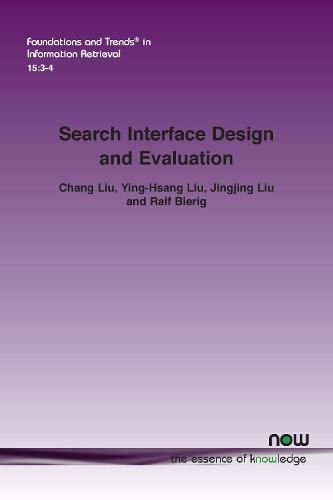Readings Newsletter
Become a Readings Member to make your shopping experience even easier.
Sign in or sign up for free!
You’re not far away from qualifying for FREE standard shipping within Australia
You’ve qualified for FREE standard shipping within Australia
The cart is loading…






This title is printed to order. This book may have been self-published. If so, we cannot guarantee the quality of the content. In the main most books will have gone through the editing process however some may not. We therefore suggest that you be aware of this before ordering this book. If in doubt check either the author or publisher’s details as we are unable to accept any returns unless they are faulty. Please contact us if you have any questions.
Information seeking and use is now routine in people’s everyday lives. Searching through various information retrieval systems such as web search engines or search functions within information systems allows users to gain access to information on the Internet. Whereas most research in this area has focused on the algorithms behind the search engines from technical perspectives, in this monograph, the authors focus on the search interface, the place where searchers interact with the search system.
Search Interface Design and Evaluation reviews the research on the design and evaluation of search user interfaces of the past 10 years. The authors’ primary goal is to integrate state-of-the-art search interface research in the areas of information seeking behavior, information retrieval, and human-computer interaction. The monograph describes the history and background of the development of the search interface and introduces information search behavior models that help conceptualize users’ information needs. The authors also characterize the major components of search interfaces that support different subprocesses based on Marchonini’s information seeking process model, review the design of search interfaces for different user groups, and identify evaluation methods of search interfaces and how they were implemented. Lastly, they provide an outlook on the future trends of search interfaces that includes conversational search interfaces, search interfaces supporting serendipity and creativity, and searching in immersive and virtual reality environments.
$9.00 standard shipping within Australia
FREE standard shipping within Australia for orders over $100.00
Express & International shipping calculated at checkout
This title is printed to order. This book may have been self-published. If so, we cannot guarantee the quality of the content. In the main most books will have gone through the editing process however some may not. We therefore suggest that you be aware of this before ordering this book. If in doubt check either the author or publisher’s details as we are unable to accept any returns unless they are faulty. Please contact us if you have any questions.
Information seeking and use is now routine in people’s everyday lives. Searching through various information retrieval systems such as web search engines or search functions within information systems allows users to gain access to information on the Internet. Whereas most research in this area has focused on the algorithms behind the search engines from technical perspectives, in this monograph, the authors focus on the search interface, the place where searchers interact with the search system.
Search Interface Design and Evaluation reviews the research on the design and evaluation of search user interfaces of the past 10 years. The authors’ primary goal is to integrate state-of-the-art search interface research in the areas of information seeking behavior, information retrieval, and human-computer interaction. The monograph describes the history and background of the development of the search interface and introduces information search behavior models that help conceptualize users’ information needs. The authors also characterize the major components of search interfaces that support different subprocesses based on Marchonini’s information seeking process model, review the design of search interfaces for different user groups, and identify evaluation methods of search interfaces and how they were implemented. Lastly, they provide an outlook on the future trends of search interfaces that includes conversational search interfaces, search interfaces supporting serendipity and creativity, and searching in immersive and virtual reality environments.